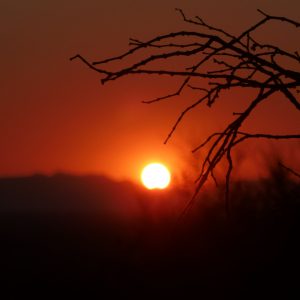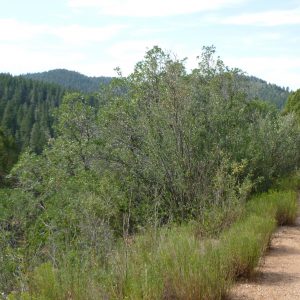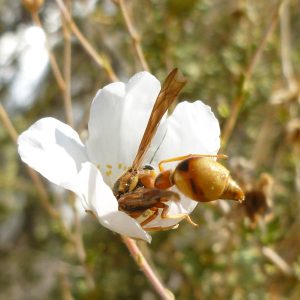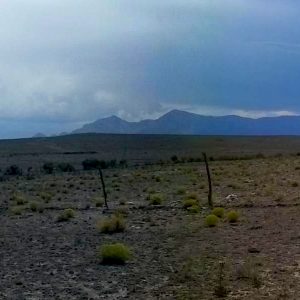It’s been a dry, dry year. Our range field monitoring has officially ended now that everything is yellow. So now its on to new projects. We were able to continue some riparian vegetation monitoring, and will begin analyzing it for the first time when we get some free office time. We also just finished a limber pine survey, trying to find some healthy trees that have mostly escaped the rust for use in seed collection later. Our main project now is surveying BLM fences, especially around significant wildlife areas. We’re hoping to get a good survey of the types of fences, particularly not wildlife friendly fences so they can tagged for sage grouse, or have the sheep fence removed for pronghorn. I’m thinking this will be able to keep us quite busy until its time for another new project.
In the past two months seed collection has been slow and my mentor allowed me to work with other botanists at Rancho Santa Ana Botanic Garden on other projects in the field. The first project that I participated took me to Sequoia and Kings Canyon National Parks to look for non-native and rare plants in the Jennie Lakes Wilderness Area. This consisted of 8 to 10 mile hikes and lots of surveying. We ran into groups of hikers from all over the world, from Japan to Germany. Leroy Gross, the senior curatorial assistant at Rancho Santa Ana Botanic Garden led the trip. At the summit of Shell Mountain we found pockets of the rare Dicentra navedensis, a relative of the cultivated bleeding heart and clearly related to Dutchman’s breeches (Dicentra cucullaria) if you happen to be from out east like I am. We made vouchers of all of the rare plants and associated species located in the area. No photos exist from the Shell Mountain population to our knowledge, so we snapped a couple and made our way back down the mountain.
In the high altitude meadows we visited we collected and documented several populations of Ivesia campestris. To our delight we found no non-native plants in the Jennie Lakes Wilderness. This was suprising, considering the amount of hiking and large number of horses that travel on the trails. My favorite plant was the native Phleum alpinum, a grass that has a light purple inflorescence. At first I thought it was Timothy (Phleum pratense), because of its association with horses.
-Pine drops-
The fall rains are causing the fall fruting annuals to spring to life. In some areas of the desert there has been 10 inches of rain in the past 2 months! We’ve gone from drought conditions and one of the lowest spring melt years on record to recieving 400 percent of the normal fall precipitation, all in one year. In areas above 4,000 ft., the contrast is astonishing. There we find Joshua tree savannahs, with large annual diversity, including 5 species of fruiting Bouteloua. I’m really looking forward to making seed collections, because the mid-summer was almost exclusively Bebbia juncea and Larrea tridentata collections. Insect damage was high, possibly because insects were eating outside of their preferred forage because nothing else was available. I’ve also completed my vouchers for the spring, labelling them and getting them ready for shipping.
This week I’m going out to the central Mojave in an area close to the Old Woman Mountains. This area recieved so much rain a month ago that 2 major highways were shut down because of the flash floods; we were conducting field work at the time and had to return to headquarters because of the conditions. I’ll be heading out with Dunan Bell, a botanist with an encyclopedic knowledge of desert flora. He scouts for populations of rare plants in the Mojave and Sonora deserts and I hope to make seed collections while contributing to his project.
Monsoons: Not Just for India
In spite of a drought, the weather in Carlsbad, New Mexico has lumbered along its yearly cycle and reluctantly settled into the monsoon season. Rain is now a force to consider in daily life. Gone are the days of leaving the bicycle in the backyard without thought for rust or a soggy backside. At any time summer showers can drench bikes and gardens alike. Big storms create the Canal Street Lake, a traffic impediment that survives the dry spells between storms on the lips of townsfolk grumbling about the municipal drainage system. But mostly, the rain in Carlsbad is insubstantial. Sometimes, withered by the hot, dry air, rain drops evaporate down to nothing before they reach the ground, a phenomenon known as virga. The gray sheets hang limply in the air, teasing the thirsty plants and animals below. A good rain, though, can make the desert bloom. For some persistent grasses, like Sporobolus, a few inches are all it takes for green growth endure for another year. Helianthus (sunflowers) on the other hand, perk up right after a rain but wilt again within weeks without a repeat performance.
At the office, griping about the rain varies by department. For range, responsible to ranchers and their grass-hungry cattle, whatever rain has fallen is never enough, and even if it were, it didn’t fall in the thirstiest places. Their hope is for the next storm. The cavers, meanwhile, are disappointed. The same rainwater that creates the whimsical features in our limestone and gypsum caves also transforms these passages into turgid, one-way tickets to the underworld. This of course precludes caving. But others are also concerned about safety. To look at a storm and see past the water, talk to a firefighter. For them, storms are carriers of the “money lights,” lighting strikes that magnify both their compensation and the dangers they face when combating a blaze in remote areas whose main groundcover is tinder.
While most rain brings life, for about a month I’ve helped supervise a rain of death. As part of the Restore New Mexico program, the Carlsbad Field Office has been spraying Tebuthiuron herbicide on thousands of acres to suppress overabundant creosote and whitethorn acacia, thereby promoting grasses. My duty in this treatment? I follow on the ground to make sure the herbicide pellets fall where they’re supposed to, avoid where they’re supposed to, and that the pilot returns safely. The Tebuthiuron, or “spike,” is water activated, so the pellets sit on the ground until the next rain releases the poison, which quickly kills the brush. Controlled burns years later remove the remnants and the final result is beautiful grassland. At least, it as long as we get some rain.
All Over Colorado
It’s great to be able to measure and monitor a plant population that has been studied for many years and see whether the population is improving or declining. Working at the Colorado state office, we have the amazing opportunity to visit various sites, meet new people from all over Colorado, and work with other field offices. These are some of the places that we have visited this summer. On each of our trips I learn something new about the state of Colorado and my amazement by the beauty of the colors of the soil of the mountains never ceases to amaze me. I’ve finally come to the realization that I am actually not in a dream working as a CLM Intern for the BLM Colorado State Office, but that THIS IS reality and truthfully it feels awesome!
Monitoring rare Penstemon species only found on the tops of precarious sand dunes that seem to almost melt away when too much weight has been pressed upon it. And the list of locations goes on and on….

Meeker, Colorado trip monitoring plot for the Physaria congesta (scientific name has probably changed based on the USDA PLANTS website)
Happy Travels!
Darnisha Coverson
BLM State Office Colorado
Never a Dull Day Around Here
Since I last posted, we have gotten to do some FUN things. It has been an exciting past month or two, and I’m pumped to share.
Cave Swallow Mist-netting & banding in C-bad
-The other CBG Intern and I had the opportunity to meet up with the folks at the Carlsbad, NM BLM office for their weekly tradition at Carlsbad Caverns National Park. Every week, for the past 30 or so years, scientists and eager interns participate in the mist netting surveys of the cave wwallows. This study was started awhile back in attempts to figure out where these birds nest in the winter. Since then, there has been a vast amount of data collected on the birds and each week more data is added to it. Basically, at the mouth of main entrance of the cave, we set up a large net and waited until we caught about 10 or so birds. It was easy to tell if the birds were older and had been caught a couple times, versus the baby ones, because the little ones squawked and freaked until they tired themselves out! Upon getting about 10 birds, we would take the net down, and carefully try to untangle them from the net. This proved to be quite the challenge sometimes. The older birds would usually just hang there and take it, but the young ones would get nervous and make it worse! Once they were finally untangled, either their existing band information was noted, or they got a new band, and simply released back into the cave. This went on for a few hours until the grand finale – the bat flight. Everyday, hundreds of people come to the Caverns to experience the bat flight. There is even and auditorium style set up at the mouth of the cave for easier viewing. Once it got dark enough, we quickly packed up our belongings and posted up on the sides of the cave. And only a few minutes later, you could hear a very low hum – that grew louder, and louder – until … BATS! And literally millions of them came spewing out of the cave. It was quite the experience, I highly recommend it!
How many interns does it take to catch a lizard?
-Normally, we work with the range department in the office and slowly check our way through a long list of sites-to-be-monitored. Same goes for the wildlife crew. So we decided to mix it up on two separate days, the wildlife crew came out with the range, and then on another day we went out in the field with them. In our field office, there are two different endangered/threatened animals – the Lesser Prairie Chicken and the Sand Dune Lizard. On the day we went to see what it’s like to be a wildlife intern, they were going to check some traps previously set out for the Sand Dune Lizard. All was going well until one of the wildlife interns caught site of a lizard. For the next 10-15 minutes, all ten of us were crawling, jumping, diving in the sand, and occasionally waiting very still for this little lizard to come back out. And finally, it was captured! We were all very excited and us range interns carefully watched as the proper documentation was taken for this endangered species. After we gently put it away, the pictures were reviewed by the wildlife biologist, only to our dismay, it was NOT a Sand Dune Lizard! So sad, but it was fun in the mean time.
Exploring the Recreation Areas
-Yet another fun thing we did a few weeks ago was a caving trip! A group interns went out with the cave specialists and the recreation planner to inspect the caves. It wasn’t my first time caving, but it was my first time caving in the southwest, and it was hot! The cave was in the desert, and even though we were underground, it didn’t get much cooler inside. But it was still lots of fun and I’m happy we got to do it. We saw a few cool things, such as a dead porcupine, and one of the other interns had a very close encounter with a very large rattlesnake. I felt very fortunate to be able to explore the cave at all, because due to white nose syndrome, all of the caves in the Roswell Field Office are closed. However, the cave specialists introduced us to the proper decontamination methods in order to keep the cave in pristine condition.
New Mexico Native Plant Society Annual Conference in Alamogordo, NM
-Thanks to the Farmington CBG Interns (Shout out to Diedre and Henry!) we found out about the Native Plant Conference that was August 9-12. The Native Plant Society is an organization that not only promotes the use of native plants but also gives a lot of support to students in New Mexico pursuing plant research. Myself and the other interns here headed over and decided to camp out at a state park near by, and commuted to and from the conference, which was at the local branch of New Mexico State University. There were a variety of lectures, seminars, and hikes. We also viewed a documentary about Aldo Leopold called Green Fire. Overall the whole conference was a great experience. We chatted with many people who have been in the “business” (or some sort of dealing with plants) for their entire lives. It was an eye-opener for potential career paths and networking possibilities. And, on top of all that, we went to White Sands National Monument Saturday night, just in time to view a meteor shower. 🙂
Besides all the extracurricular activities we’ve gotten to participate in, we have also been doing different types of monitoring studies. I definitely enjoy these because it only broadens my scientific horizon. I am also starting a side project here with the Recreation Planner and also the Oil & Gas Environmental Consultant. Together, we are creating a wildflower brochure for at least two of the recreation areas in the Field Office. I am extremely excited and proud of this project, even though it is still in its’ beginning phases. Hopefully the next time I post I will have many more details about the project.
Hilarious 90’s Style BLM Rap Video… a MUST see.
Lichens and backpacking
In the past month, I have been steadily working on my three lichen projects. My academic paper on new and interesting lichens to Florida (which may become two or three papers) is very close to completion. The key to Florida macrolichens is also close to completion and will be finished by next month’s post. Lastly, digitization of the lichen collection at Boise State University progresses steadily.
On weekends, I have been able to travel around Idaho in the past month, and soak in the beauty of the state. Two weekends ago, I went to a small town north of Boise. The town is known as Cabarton, which is really a pioneer town that is now a road. The town was important in the 1800s because it had a stagecoach station (which now sits on my friends property). A short distance down the road, is the North Fork of the Payette River. I was able to boat down it as a passenger. Its hard to describe the beauty of water swirling, in rapids and calm eddies. All the while looking up into the peaks of mountains dominated by Douglas fir forests.
Last weekend, I went backpacking in the Pioneer Mountains. The area I climbed was around Hyndman Mountain, which was just over 12,000 feet. It was my first time over 10,000 feet and 11,000 feet. On one hike I had a clear view of 30-40 miles and of the valley below. Personally, it was important to get outside and see what I am protecting and enjoy the scenery. I was amazed that even at 11,000 feet there were lichens growing in the alpine soil. My boss has no records of lichens in the Pioneer Mountains, so I hope to curate them and donate any significant lichens to the BSU herbarium.
Barry
BLM Idaho State Office
Stop, drop, & roll, it’s fire season!
The past few weeks at our field office have been quite hectic and exciting. The Lost Fire scorched over 60,000 acres in our resource area, and the almost record-breaking Rush Fire snuck its way into the southern section, burning another several thousand acres. Our tiny field office has been filled with fire specialists from around the district and state office.
Once the fires were controlled, the real work started. Our field office was responsible for a Burned Area Emergency Response (BAER) plan very soon after. I was able to help my mentor design a reseeding plan for the BAER. It was an incredibly valuable experience. I learned all about different aspects of fire ecology, and how BLM responds to fire. Coming from the Northeast, this was all new information and very interesting. It was also great to be a part of a team of specialists working towards a short deadline. Now we just have to collect the native seeds for these projects. Hopefully, we’ll be able to muster a volunteer team because we’re going to need a lot of seed! Get ready Bend!
Back to the Office!
I am starting my fifth month with the West Eugene Wetlands, and with the start of September comes the end of field season. The past four months have taught me more than I ever thought imaginable, especially since I studied Literature in college. Before this internship, I could not identify a single plant. Now, after working with the monitoring team all summer, I feel like I have made leaps and bounds in my knowledge. In addition to the sensitive species we’ve been monitoring, I can now identify several grasses and forbs found in the wetlands (though I still find sedges and rushes a bit tricky).
Now it’s back in the office for me. It has taken a bit of time to adjust, going from tromping through the prairie all day to sitting at a desk. It’s time to prepare monitoring reports for each site. This has been interesting, as I get to review the history for each site. I’ve also gotten to complete some training on ArcGIS, which I have found to be quite entertaining. In between managing the reports and training, I’ve once again had time to work on my summer-side project: compiling an identification book of grasses, sedges, and rushes. This has been both interesting and confusing, since right now the vocabulary in regards to grasses, sedges, and rushes is quite a challenge. Needless to say, my ID book will have a glossary.
Although field season has ended for the monitoring crew and me, restoration treatments are starting to be implemented in the wetlands. I returned from Labor Day weekend to discover that the fire crew had worked through the weekend and burned one of our office’s neighboring sites. Viewing the aftermath, I must say, I was a bit surprised: I expected that all vegetation would be burned, when in reality it was only the grasses and forbs, getting them ready to flush next spring. Even though field season has ended, I learn something new about the wetlands every day.
It is the ending to a great start.
Away I go to places of utter beauty.
I leave for wonderous sights are left to see.
A sticky situation
Yesterday we spent the day helping with data collection for a study on the restoration of pollinator habitats in California. Researchers have created different mixes of native wildflowers that are attractive to pollinators. From what I understand, one goal is to identify a mix of easy-to-manage plants that will support a diverse group of pollinators throughout the year.
We have four different plots planted with different mixes here at the PMC and a group of researchers came down to collect data. I was very excited to learn about the project and help out. My fellow CLM intern and I were set to work collecting data on flower counts across several transects through both mowed and unmowed areas. Around this time of year, poppies (Eschscholzia californica), sunflowers (Helianthus bolanderi), gumplants (Grindelia camporum), and madia (Madia elegans) are all in flower.
Madia was densely distributed throughout the unmowed areas in one of the plots. The plant is fragrant, can grow to about 2.5 meters in height, and is sticky. Very, very sticky. Navigating through the dense maze of madia with a quadrat was quite the challenge. By the time we were done with our sampling, we were covered in plant material and sticking to everything. It just serves as a reminder that although a plant may be highly beneficial and useful for some purposes (like attracting pollinators), there can be unforeseen challenges in managing that plant. Nonetheless, it was quite interesting to see some of the considerations that go into deciding which plants should be used for these projects.

















